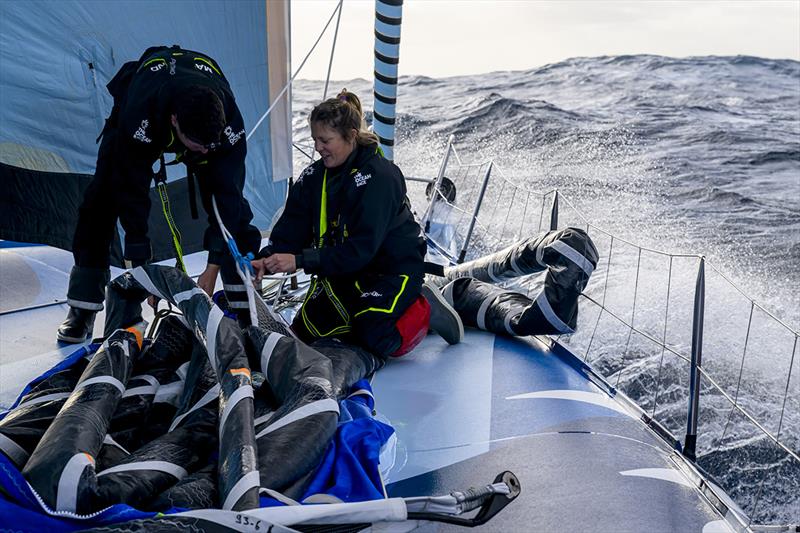
Charles Caudrelier: This epic race through the Southern Ocean will not be about optimal routing
by Ed Gorman / IMOCA Globe Series 1 Mar 2023 08:04 GMT
1 March 2023

The Ocean Race © Ronan Gladu / Biotherm
Charles Caudrelier, skipper of the Maxi Edmond de Rothschild and winner of the last ex-Volvo Ocean Race, says the IMOCA crews on Leg 3 of The Ocean Race are not going for the same routing choices as he did in a Volvo Ocean 65.
And that's because in this fleet of what he calls "prototype" IMOCAs, boat preservation is more important than going as fast as possible in the strongest conditions available on the way from Cape Town to Itajaí in Brazil.
As the five IMOCAs, led by Kevin Escoffier's crew on Holcim-PRB, tackle their first day in downwind conditions off the top of a big low pressure system centred SSE of Cape Town, Caudrelier has been watching their collective decision to stay well north of the main area of the system.
"My feeling is that probably none of the boats will finish this leg in perfect condition," said Caudrelier, who remains on standby for this winter's Jules Verne Trophy attempt on the Maxi Edmond de Rothschild. "It is a really tough stage and the boats are new - the foiling boats are still new - and I think the challenge is to find a good balance between speed and reliability."
"We can see that they are not doing the optimal routing because they want to avoid strong winds and big waves and, for sure, everybody has that in mind in quite new boats and everybody wants to take care of their boats," Caudrelier added.
In contrast, he recalls, he and his crew on the VO65 Dongfeng Race Team hammered the boat through the Southern Ocean in the 2017-'18 race, confident that the hull and rig could take it. "In the 65s, we were pushing the limits a lot because it was a one-design class and because the boats were strong," he recalled. "Here it is different because they are prototype boats and we know they are not as strong as the 65s were. But it is much more interesting because you have to manage that - it is a different race, managing the boat - not pushing it to the maximum."
Chased by Benjamin Dutreux and his team on Guyot Environnement-Team Europe, Escoffier has led this action-packed leg almost from the start. They were the first into and out of the area of light winds, south of the Cape of Good Hope, and they are now the most southerly boat of the five, as the speeds increase on the way east.
"I think they are doing well and the crew is working pretty well together and, for sure, Kevin has much more experience with IMOCAs than anybody else in the fleet," said Caudrelier of his former crewmate on Dongfeng Race Team. "And that could be his advantage because, as a designer and a sailor, he is very complete and his experience of IMOCAs is huge."
"Even though 11th Hour Racing Team (skippered by Charlie Enright and currently in fourth place, 95 miles behind Holcim-PRB), spent much more time training for this race, they made some mistakes - I think - with sail choice and other things that Kevin did not do. So, although he had less time, he was probably smarter in his preparation because of his experience with IMOCA."
Back home in Brittany, Caudrelier says everyone involved in offshore sailing and in the IMOCA Class has been following this leg very closely. "Yeah, of course, they are all watching because they want to know - and to understand - why a boat is faster and which sails they are using. We are all trying to spy, looking at the videos from the boats, to see what is happening, because there are plenty of questions. The foiling IMOCAs are much faster than before upwind and reaching, but downwind it is not the case and everybody is looking for solutions - and the solutions are in the hull shapes and in the foils, but there are still many questions to answer, so it makes the race very interesting to follow," Caudrelier said.
Like many observers, Caudrelier is expecting the VPLP-designed Malizia skippered by Boris Herrmann (third place; +90,7 miles) to show her paces on the stage to Cape Horn. "The boat looks to be fast in strong waves," said Caudrelier. "It's the shape of the hull that makes it slow in most conditions except in strong winds, so it could be an interesting boat on this leg."
With his long experience as a leader in the Southern Ocean, Caudrelier knows just how tough this leg is going to be. He says, for the skippers, keeping people happy and working together, is a big issue. "What was interesting in the Volvo was the human challenge of sailing for such long distances and keeping the team motivated for such a long time. So this leg is really interesting in that way," he said.
"But it's tough for sure. It's an incredible challenge, especially on IMOCAs with five people on board - it's a big challenge, so much so that it was tough to find crew to go on this leg. I think the skippers asked many people who said they wanted to do The Ocean Race, but not this leg!"